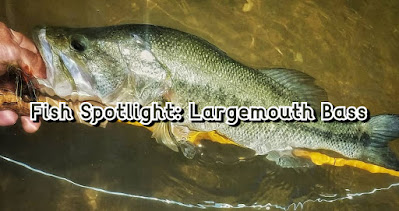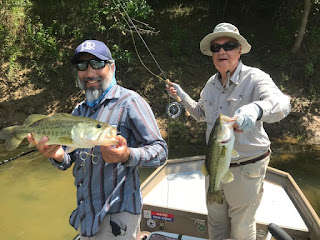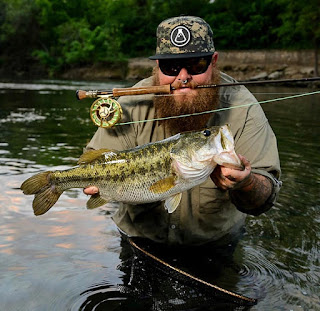 |
| Photo by Ryan Gold |
The Guadalupe Bass is the state fish of Texas, but love it or hate it, the Largemouth Bass is the king of fish in Texas. It dominates as the top target species of fishermen here in the Lone Star State. Conventional or fly fishing, it is the most targeted species. Largemouth Bass often strike with viscous aggression, will fight and fly around, and make for some of the best braggin' rights pictures on Facebook and Instagram.
But what is the Largemouth Bass, and why is it the top-dog in the Texas fishing-sphere?
 |
| Photo courtesy of Mike Schlimgen Caught on the San Marcos River |
Also commonly referred to as Black Bass, Bigmouth Bass, Bucket Mouth, or Lineside, the Largemouth Bass (Micropterus salmoides) is the most fished for fish in Texas, by far. Bass fishing in Texas also brings a pretty penny in for the local, state, and federal taxes. According to the 2006 Economic Benefits of Hunting, Fishing, and Wildlife Watching study that was done for Texas Parks and Wildlife, black bass fishing in Texas alone brought in $98,549,162 in taxes for the Federal Government, and another $77,839,762 for state and local governments in Texas. Bass fishing is big bucks.
There are actually two strains of Largemouth Bass in Texas now, and that is a big part of why Texas has become so engulphed in bass fishing. The native Northern strain Largemouth Bass (Micropterus salmoides salmoides) and the introduced Florida strain Largemouth (Micropterus salmoides floridanus.) More on how/why the introduction of Florida strain Largemouth Bass changed Texas later.
Appearance
 |
| Classic color pattern of a Largemouth Bass Photo courtesy of Riley Henderson (White Rock Creek) |
 |
| Jaw on a Largemouth extends past the eye of the fish Photo courtesy of Matt Bennett (Lower Colorado River) |
The average Northern strain Largemouth will typically not grow any larger than 10 pounds, whereas the Florida strain Largemouth can grow upwards of 20 pounds (or more.) This size difference can possibly be attributed to where these two strains evolved. The Florida strain is built to ambush prey in the warmer, shallower, grass filled lakes of South Florida. The native Northern strain Largemouth bass was built to live in cooler, often flowing waters, and to actively chase down their prey in the open.
To tell the two strains apart, unless you have access to DNA testing, the "best" way is to observe the scales of the fish. The Northern strain will have larger scales in comparison to its body size than its Florida strain cousin. If you were to count the scales along the lateral line of the fish, a Northern strain Largemouth will have between 59-65 scales to a Florida strain's 69-73. However, in Texas, many if not most, of the Largemouth Bass you will catch are a some sort of hybrid of the two and the scale counting numbers are skewed.
 |
| Photo courtesy of Marcos Rodriguez |
Diet and Behavior
Once a Largemouth bass becomes an active predator (around 2 inches in length) their diet consists mainly of other fish (including other bass), large invertebrates (like crawfish), and pretty much anything that might be swimming around in their waters (like frogs or baby ducks.) Northern strain, being more active predators by nature, will tend to be more aggressive, and therefore more likely to attack your fly. Florida strain Bass, tend to be less aggressive and often "harder" to catch.
 |
| Photo courtesy of Joan Piassick Swartz (Photo credit to Christine Murrell) Nueces River (Check out Texas Women Fly Fishers) |
Largemouth Bass spawn when the waters warm up to around 60 degrees, anywhere from February to Late May in Texas. The males will first build a bed, typically in 2-8 feet of water, but will build them deeper in water that is very clear. Largemouth Bass tend to choose locations for their beds that are quieter and more vegetative than the other native Texas basses. Females will then come and lay between 2,000 and 43,000 eggs on these beds in a season. Often, females will lay eggs on more than one bed, and males will have more than one females eggs on his bed.
The male will feverously guard his nest, and after the eggs hatch, he will guard his fry for a few days. This puts enormous amounts of stress on the male bass, and sometimes, especially if he was in poor condition prior to the spawn, the male bass can die.
 |
| Photo courtesy Jordan Noe |
Distribution
 |
| Orange = native range of the Largemouth Bass; Red = Introduction of Largemouth Bass in contiguous US Map from USGS |
The native range of the Florida Largemouth is restricted to the Southern portion of Florida.
 |
| Orange = native range of the Largemouth Bass; Red = Introduction of Largemouth Bass in contiguous US Map from USGS |
Why Stock Florida Strain Bass?
 |
| Photo courtesy of Grant Powell |
 |
| Photo courtesy of Chris Fowler |
 |
| Example of an F1 bass caught in a private pond Photo courtesy of Ryan Clarke (Fatties on the Fly) |

Comments
Post a Comment